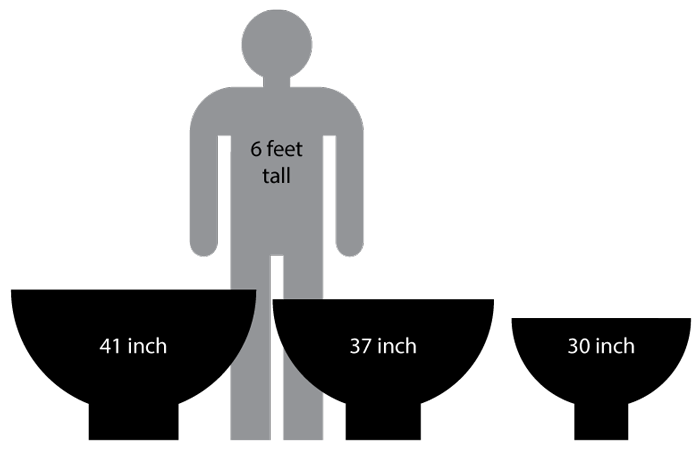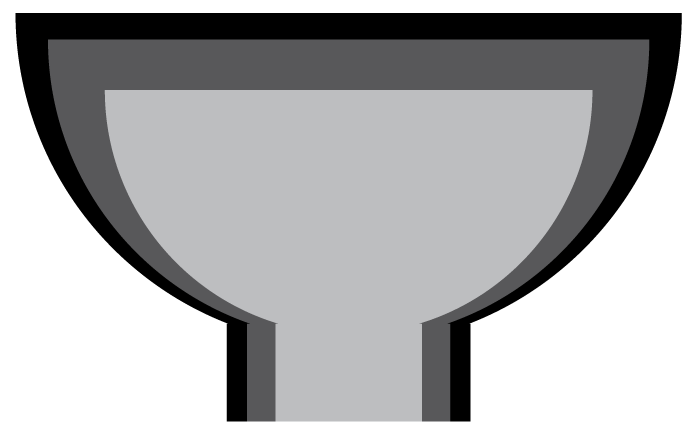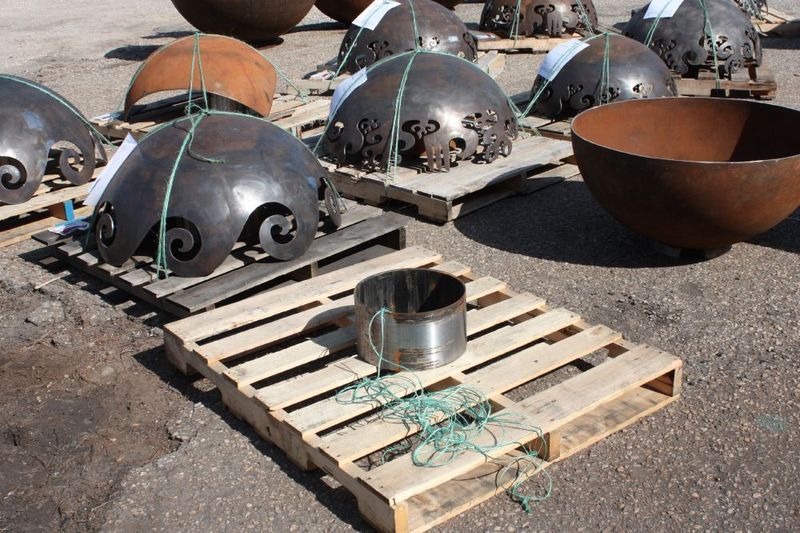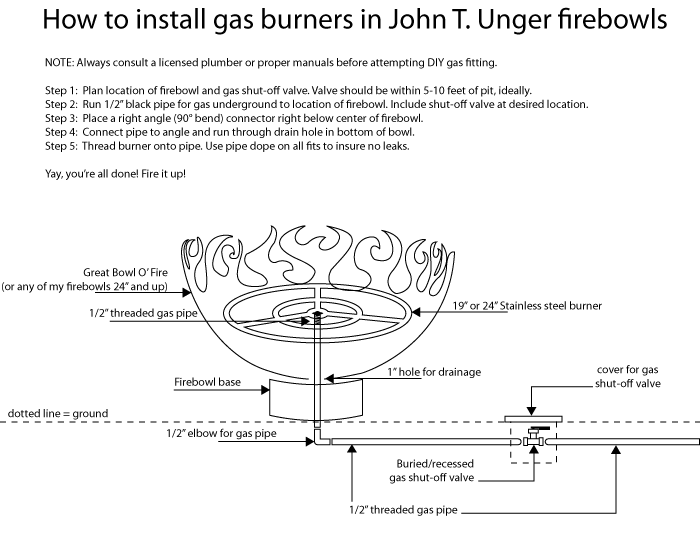
Frequently Asked Questions
1. How are your firebowls made?
My Sculptural Firebowls are hand-cut by the artist from 100% recycled industrial tanks using a 35,000°F plasma torch. They are not: produced by CAD/CAM automated cutting, cast, welded, forged, spun, stamped or machined.
The material of the firebowls is American made high-strength, low-alloy, cold-rolled steel (also known as mild steel). It is not: Iron, stainless steel, copper, tin, aluminum or any other metal.
It is increasingly common for web retailers to use terms interchangeably to try to boost search optimization, but as a metalworker and artist I feel it is important to describe materials and method correctly. It’s also not uncommon that when looking at a photo, people assume that an item is copper or stainless because of coloration.
2. Do firebowls get hot when in use?
It depends on the type of fuel you use and how you set your firebowl up. Steel is a good conductor of heat, so Sculptural Firebowls can get hot.
You can prevent your firebowl from heating up by converting to gas. A space of 3-4 inches between the edge of the burner and the edge of the bowl should provide enough of a heat sink to keep the bowl relatively cool. To insure you get the right size burner to avoid heating the bowl, it is best to discuss your needs with the burner vendor when you place your order. He will need to know the size and design of firebowl you are converting to gas.
If you use your Sculptural Firebowl to burn burn wood, it WILL get hot. In a wood burning firebowl, the coals are right up against the metal and will transmit heat to the bowl and it’s base. The bowl remains hot for several hours after the fire has died down.
3. Are your firebowls safe for kids?
That depends on you. Just like an iron, a pan on the stove or any other item which gets hot or is sharp, proper supervision is required.
Please note that like any fire pit, the bowl does get hot and can retain heat for several hours after a fire has burned down to embers. Some designs have sharp points or angles. Please exercise proper caution.
4. What size firebowl should I choose?
This scale drawing shows all three sizes of Sculptural Firebowls™ side by side.
The standard and most popular size is the 37 inch diameter Sculptural Firebowl. Most people much prefer the 37 inch size to the 30 inch when seeing the firebowls in person. They’re more functional. They have greater presence and drama.You can gather more people around the 37 inch and sit more comfortably.
Although the 41 inch size doesn’t sound that much larger than the 37, it really is a significantly larger bowl— remember, when you scale up a sphere, it grows larger in all directions. If you are looking for a real centerpiece for your landscape design, I highly recommend the 41 inch size. That’s what I have at our house.
The 30 inch size is great for smaller spaces or specific projects where the focus is more about decor or ambiance than actually sitting around the fire. I know budget is one reason people consider the smaller size, but I can’t recommend strongly enough, price should never be the primary consideration in selecting one piece of art over another. If you’ve already decided to invest in a work of art that will be a daily presence and a legacy for generations, make the choice based on how it makes you feel and how it fits your space.
This scale drawing shows all three sizes of Sculptural Firebowls™ nested, or, one in front of the other.
5. Will my firebowl look like the picture on your site?
Yes. This question is best broken into two parts though— design and color.
Design: Because all Sculptural Firebowls are hand-drawn and hand-cut, there are minor variations… but if you were to line up 5 or 6 of the same design, you would have a hard time telling them apart.
Color: The rich, warm color of the firebowls is a natural patina which takes some time to fully develop. I apply the patina to all bowls before cutting them, but when I clean up the spatter and slag caused by cutting, it removes some patina around the edge of the bowl. The patina will naturally return to the cleaned edges and the entire bowl will develop a uniform look fairly quickly.
If you wish to speed the patina process, you can use the following non-toxic patina formula to get a full, uniform patina overnight:
4 parts white vinegar,
1 part hydrogen peroxide (3%)
1/2 part salt.
Mix the ingredients and spray the bowl thoroughly. It’s best to apply a couple coats as the spray dries. Once the patina has developed, rinse the bowl well with fresh water.
Note: In some of the older photos on my site, the base appears as a shiny silver color. This was the result of using freshly ordered steel on the day of the photo shoot, but the bases will actually have the same color as the bowl.
6. Can you do custom sized firebowls?
Because my firebowls are created from recycled steel tanks, there are some restrictions on size or shape. I am limited to the industry standard sizes that are commonly produced. Those sizes are 30, 37 and 41 inches in diameter.
The hydraulic presses used to make the bowls are giant machines the size of a house, exerting 800 tons of force. There are only about a half dozen companies in the US that have the machinery to make such large bowls from heavy steel. Here’s a video that shows one of the presses in action.
On very rare occasions, I’ve found antique tanks in larger sizes like 48 or 53 inches in diameter. I’ve found maybe 8 of those in ten years. If I have them, they’ll be in the store. Those sizes are no longer produced commercially. I’ve tried many times to find a contemporary source for these larger tanks without success.
7. Will you do custom firebowl designs?
Yes. I love doing something new and fresh and welcome your ideas. Visit this gallery to see custom designs I’ve done in the past.
If you are interested in a custom firebowl design, the best way to start is to send me an email from the form on the contact page. The more you can share about your ideas, the better. With custom work, the focus is all about making sure you get exactly what you’re looking for.
It’s important to spend time developing the design together, because once the steel is cut it can not be uncut! We’ll discuss the idea over the phone, collaborate on image research for the subject matter and I may ask you to try drawing your idea or sending photos that describe it.
Pricing for custom firebowls is based on time and materials. Custom orders are more expensive than stock designs due to the fact that it always takes much longer to do something the first time. Pricing for a custom design can range anywhere from 100% more to 300% more than the price of a stock design, depending on size, complexity and how difficult it is to lay out before cutting. The more exactly you are able to tell me what you want, the more accurately I can bid the price for you.
Small modifications to an existing design (such as cutting an extra hole or welding tabs to the base) can often be done for $100 or so.
8. Can you copy a fire pit design I saw elsewhere?
Absolutely not. My designs are protected by copyright and I strenuously enforce my rights when my designs are copied. I can not then copy another artist or maker’s work. If you saw a design you like elsewhere, you should purchase it from the original artist or designer.
Usually when people look for a copy of work they saw elsewhere, it is a price issue. In most instances, it will be most cost effective to buy work from the original designer anyway— they will have figured out the most cost effective way to produce their own work. Anyone making a copy would be starting from scratch and it would take longer to do.
If you find someone willing to make a copy of another artist’s work at a reduced price, there is usually a hidden cost: whether it is quality of material, artistic skill, customer service, accountability, on time delivery or something else, copies are never as good as the original.
9. Can you make firebowls in copper, bronze or stainless steel?
Stainless steel firebowls are in the works and will be available shortly. If you are interested is stainless, please join my mailing list to be alerted when they are released.
Unfortunately, copper and bronze are so expensive that I have not found an affordable way to offer them. I’ve investigated having my designs cast in copper or bronze, but the actual cost of the casting (with no markup, profit or shipping cost added) was over $7000.00 apiece.
If I can ever find a way to produce sculptural Firebowls in bronze or copper at a reasonable cost I will certainly do so.
10. How much does a firebowl weigh?
The total weight for each design is listed in the Specs tab on its sales page.
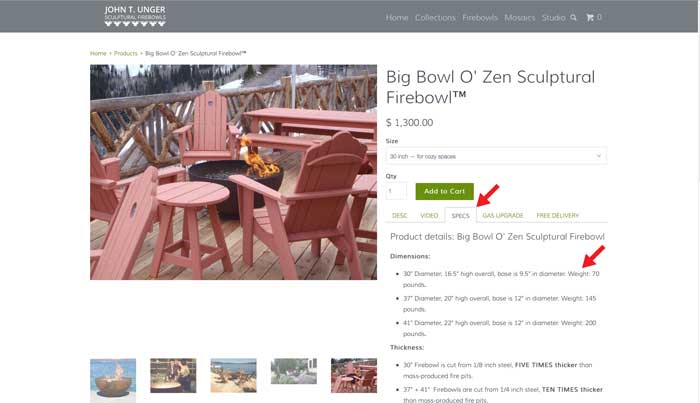
The bases for the firebowls weigh between 30-40 pounds. Stock firebowls weigh between 40-200 pounds depending on size and design. The detached base makes it easy for one or two people to move safely. I find that the easiest way to move most designs is by rolling it like a wheel.
The shipping weight of the firebowls is 50-100 pounds more, to include the weight of the pallet or crates when shipping internationally.
Want to compare specs for different firebowl designs? View this chart which lists all my Firebowl designs and shows the weight, the correct size for burners and pans, how many pounds of glass each design holds and how many BTUs they use.
11. Are the firebowls stable?
My firebowls are designed to be quite stable and are quite difficult to tip over accidentally. The curve of the bowl nests into the detached base, and the weight of the bowl itself helps to keep it in place.
Some designs (like the Big Bowl O’ Zen) have a base that is 2 inches high. All firebowls with this shorter base have the base welded on.
Designs with taller bases are not welded together. There are two reasons for this:
• It makes it much easier to move (and to ship).
• It makes it possible to level the bowl on site during installation if the ground is not perfectly level itself.
12. What makes your firebowls eco-friendly/green?
Sustainability is a major focus of my work as an artist.
I work primarily with recycled or re-used materials to minimize my impact on natural resources, climate and the environment.
I design for permanence. Most of my objects will last generations with little or no maintenance. I try to create designs which are timeless so that they never become part of the waste stream.
I design for functionality. My work is intended to be useful as well as beautiful.
Where possible, I design for easy disassembly for shipping or later re-use of materials.
My firebowls are as eco-friendly as a firepit design can be. They are made from 100% recycled materials, and the steel is 100% recyclable itself. All the scrap generated in the studio is either used in other artwork or recycled. The design scores high on sustainability in other ways as well. The warm rust finish requires zero maintenance and no chemical treatments. Quarter inch steel plate insures the bowl will last generations in any climate. The heavy steel holds and radiates heat like a wood stove, providing more warmth for less fuel. Opt for the gas-burning upgrade to minimize emissions and risk of accidental fire.
13. Do you have a printed catalog?
More than just a simple catalog, our Sculptural Firebowl Catalog is a beautiful 38 page art book. We chose a 12″ x 12″ format that allows the photos to really show the firebowls in their best light. The catalog is hosted on Magcloud to give you multiple options for print or digital delivery. You may choose any of the following:
Preview the catalog in the browser.
Download a free PDF or iPad version.
Purchase a print copy of the catalog.
Magcloud’s print pricing is exceptional, as the same size catalog on other print-on-demand services came to almost $70. The only drawback is that we were restricted to a wire binding rather than the stitched binding I would have preferred.
14. Can I visit your studio?
Studio visits are welcome but must be scheduled at least a week in advance. Please call my mobile at 231.584.2710 or send me an email from the form on my contact page to arrange a visit.
The studio is located at my private residence and does not have a retail outlet with standard business hours. Availability depends on what kind of projects or commissions are going on at any given time.
Sculptural Firebowls are mostly made on demand and shipped as quickly as possible so there not usually very many to see at the studio. There is usually a fair bit of other sculpture and mosaic, but again, that really just depends on the current schedule of commissions and projects.
15. How long does it take you to make a firebowl?

Cartoon by Lauren Purje for Hyperallergic
Every firebowl is cut by hand using a handheld plasma torch. It is then finished by using a wire cup brush and/or sanding and grinding discs to remove spatter and slag from cutting. Some designs have the edges rounded and ground, while others retain the clean edge from the precision torch.
Each of these processes must be done at the speed dictated by the tool being used. For instance, if you cut too slowly with the torch you will get huge globs of metal stuck to the design which are hard to remove or you may even melt a large portion of the design. If you cut too quickly, the torch will not go all the way through the steel. It takes years to be able to cut perfect, clean lines at the correct speed working freehand without any guides.
The cartoon at the top of is one of the better answers to this question I have seen— the truth is, every piece of art ever made required a great deal of time that wasn’t spent specifically on the making of the piece. There are ideas I have had out of the blue that were effectively instant. But there are also ideas or designs that I have spent more than a year thinking about, researching, viewing thousands of reference images, doing tens or hundreds of sketches for, before even attempting a sample or prototype.
PAYMENT + SHIPPING
1. Do you offer a trade discount?
Yes. Trade discounts are available for designers, architects and builders with professional affiliations and credentials. Click here and fill out the form to apply for a trade discount.
2. Do you offer wholesale prices?
Yes. Wholesale pricing is available for select bricks and mortar galleries, stores and retail partners. Wholesale requires a minimum order of $5000.00 Click here and fill out the form to apply for a wholesale account.
3. What is your return policy?
All artwork sold from the website is eligible for return and replacement if it arrives damaged or broken. Sculptural Firebowls may arrive with some marks or scratches due to the fact that they are made from recycled materials. These scratches are considered to add history and character rather than being a defect eligible for return.
Commissions and custom designs are excluded from the above policy: I will refund deposits if no materials have been purchased and no work has begun. Once the deposit has been spent on materials or I have begun the piece, the deposit is no longer refundable. If for any reason you are unhappy with a finished commission or custom design, I will make a reasonable effort to help you resell it but custom work is not eligible for return or refund.
4. What is your refund policy on commissions and custom designs?
I will refund deposits only if no materials have been purchased and no work has begun. Once the deposit has been spent on materials or I have begun the piece, the deposit is no longer refundable. If for any reason you are unhappy with a finished commission or custom design, I will make a reasonable effort to help you resell it but custom work is not eligible for return or refund.
5. Do you ever have seconds, rejects or damaged work at a lower price?
No. In the rare event that a piece is damaged or imperfect, it is better to destroy it or turn it into something else than to have an imperfect piece represent my skill and quality to anyone who sees it.
My reputation is based on what people see in the work, so it is vital to ship only the best work.
6. Do you offer payment plans/layaway?
Yes. In most cases I am happy to finance a purchase via a scheduled payment plan. Artwork is shipped only when payments are completed. Buyer is responsible for making payments on time and notifying me when their purchase has been completed so that I can ship the work (ie: I’m not going to keep track of it for you but I will check your math when you tell me you’ve completed your payments).
Payments for financed artwork are not refundable in the event that payments cease before the agreed amount has been completed. They can be applied to less expensive work, or counted towards the total when payments resume at a later date.
7. How are the firebowls shipped?
Free white glove delivery is included in the purchase price for Sculptural Firebowls: Your Firebowl arrives on a delivery truck with a lift gate. A two person team will unpack your firebowl, place it in your location of choice, assemble it for you and remove all packaging when finished. The only exception is for the Isosceles Modern, which arrives curbside delivery.
Firebowls ship on reused pallets. They are securely tied face down to the pallets with biodegradable twine. The base for the firebowl is under the bowl on the pallet. Oversize firebowls and international orders will be crated.
8. What is the lead time for shipping?
Usually, Sculptural Firebowls ship within a day or two of receiving your order because I prefer to have everything done.
It is a good idea, however, to ballpark 7-10 business days in case I am traveling, or constrained by weather, illness, a large order ahead of yours, etc. If there is any reason that it will take more than 5 business days to ship your order I will let you know immediately.
Each Sculptural Firebowl is made by hand by me when the order is placed— they are not manufactured, or warehoused and there is no one else who can do them, so on the very rare occasion that I can’t be in the studio immediately I will let you know.
9. How long does it take to arrive?
Transit times vary based on distance, but the furthest states rarely take more than 5 business days in transit. 2-3 day transit times are the norm.We send a tracking email as soon as we schedule pickup.
Because the freight company requires a signature, they will call you to make a deliver appointment. The tracking email includes a phone number for the freight company and delivery is sometimes faster if you call them to schedule.
10. Can I get overnight/expedited shipping?
Maybe. But it is definitely better to plan ahead. Each Sculptural Firebowl is made by hand by me when the order is placed, so it may not be possible to have it ready in time for overnight delivery.
The cost is also a consideration. I once was able to overnight a firebowl to Key West, FL on Christmas Eve but it took 8 hours of phone calls, 3 freight companies working together in tag team and over $3,000 in shipping costs. It absolutely made the customer’s day when it arrived in time for the holiday but it sure would have been simpler and cheaper to ship it the week before!
11. Do I need to sign for delivery?
Yes. The freight company will not deliver without a signature in most instances. They will call you to make an appointment when the bowl reaches the terminal nearest your home or business.
If you can’t be there personally to sign for the shipment, maybe a friend can do it for you.
5. Do you ship internationally?
Yes! I love to have my work in as many different parts of the world as possible. I’ve shipped all over the world to more than 15 countries and it’s always exciting to add new locations.
To get a price quote for overseas shipping, please email me with your full delivery address and the size, style and quantity of the firebowl you wish to purchase. I will get a shipping quote for you within 3-5 days and provide instructions for payment. To get an accurate quote, I must have the full street address.
I bill only for the artwork and shipping cost— taxes, customs brokers and any other import fees will be the responsibility of the customer. In many countries there is no duty tax for fine art, but there may be other regional, state or local taxes.
Disclaimer:
The customer is considered the importer of the purchased products and will be responsible for any customs tax, import duties, goods and services tax (GST), valued-added tax (VAT), or any similar customs-related charges.
Customs policies vary by country and John T. Unger cannot make any guarantees as to whether or not shipments will be subject to customs-related fees. Please contact your local customs office for more information.
In addition to customs fees, customers may also incur other charges, such as administration or brokerage fees. These are handling charges incurred due to customs processing and clearance of your shipment.
FIREBOWLS + GAS
1. Which is better, wood or gas?
Whether wood, natural gas or propane each type of fuel has its own advantages. Ultimately, the choice of fuel is a personal choice and depends on your own preferences and the effect you wish to achieve.
Wood fires are what most of us envision when we think of a campfire, fire pit or firebowl. A wood fire is the classic raw element— primal, archaic, beautiful. It is almost like a living, breathing creature.
Advantages of wood:
- Your firebowl arrives ready to use, you can light a fire immediately.
- Wood fires have more variation of color than gas flames and can produce a more dramatic effect because of that.
- Everyone loves the sound of a crackling wood fire.
- Most people like the smell of a wood fire.
- No additional expense to purchase and install a gas burner system. No need to bury a gas line.
- Depending on where you live, you may have ready access to free firewood.
- Wood is a renewable resource.
Disadvantages of wood:
- Local ordinances may prohibit wood fires due to the risk of sparks starting accidental fires. In most places, the ordinances will allow a gas fire.
- A gas fire can be started with the push of a button, but you will need to build a wood fire each time and get it to light. You also need to feed it as the evening goes on, where gas requires no additional effort. However, there can be a great pleasure in feeding the fire.
- Even though the smell of a wood fire can be pleasant at first it can also become overwhelming and can stick to clothes.
- Firewood takes a lot more space to store than gas.
Gas fires: Propane and natural gas have nearly identical advantages and disadvantages. The only real differences are availability and the character of their smoke (or emissions).
Propane is readily available anywhere, which makes it the most common choice for gas fueled firebowls. Propane causes more soot when it burns than natural gas does, and the soot will color both the inside of your firebowl and any media that covers the burner (whether glass crystals, lava rock, ceramic logs, etc.).
Natural Gas is available only in select areas where pipelines already exist. Propane burns cleaner than natural gas and will not stain your firebowl or media with soot, which makes it the better choice for a gas-fueled bowl when available.
Advantages of propane and natural gas:
- A gas fire can be turned on or off immediately. You can economize with a manual light burner or opt for greater convenience by selecting a push button ignition or even a remote control unit.
- Gas fires create less smoke and particulate, hence gas fires are gentler on the environment and atmosphere.
- Your flame can be adjusted to taste but remains consistent.
- Once lit, a gas fire does not need you to feed it or adjust the flame in any way.
- The effect of a gas flame coming up out through glass firecrystals is truly beautiful.
- Gas fires are not silent, but they are quieter than wood fires.
Disadvantages of propane and natural gas:
- You will need to purchase the conversion kit separately and have it installed. Most plumbers can easily install a propane burner. Natural gas burners will need to be installed by the company that provides your gas.
- Our burners can meet any standard required by building codes, ordinances or your gas company but sometimes it takes them a while to approve installation. We are happy to help by providing any documentation or tech support needed.
2. Why are burners sold separately and where do I get them?
Questions about gas burners or accessories are best directed to the vendor you purchase a gas burner from. It’s relatively easy to find easy-to-install, drop-in kits to fit any of my designs.
I am not an expert in gas or plumbing. I’d rather you work with a contractor who is an expert in gas installations and can walk you through the many choices and variables to customize a kit to fit your project exactly.
I know it would be convenient to get everything in one place, but more important is to get the right things for your specific project.
The thing about making sculpture is— you never, ever have enough space to store materials and to make art. I simply don’t have room to warehouse all the varieties of gas kits and media. The dust made by cutting steel would quickly make anything stored in the studio quite filthy which isn’t how I’d want to ship things.
3. How many BTUs does the burner use?
Generally speaking, burners 24 inches in diameter and under use 75–100 BTUs. Burners 30 inches in diameter and up use 100–150 BTUs.
A 100,000 BTU burner will burn about one gallon of propane per hour.
For detailed info about BTUs, View this chart which lists all my Firebowl designs and shows the correct size for burners and pans, how many pounds of glass each design holds and how many BTUs they use.
4. Are burner kits UL/CSA approved?
If your project requires meeting UL or CSA standards there are plenty of burner kits which will meet those standards when installed in any of my firebowl designs.
5. How do I install a gas burner?
Installation should really be performed by your gas company or a licensed plumber.
The drawing below shows the basic concept of how a simple ring burner is installed. You can download a print quality PDF diagram here.
If your plumber or gas professional has questions about installation, give them the documentation that comes with the burner kit and/or have them speak to the company that provided the kit.
6. Can I pipe in gas from side if I am unable to bury a gas line?
It’s not uncommon for people to choose to add a firebowl after their patio or deck has already been completed. In these situations, burying a gas line is not always an option!
I can cut a hole in the side of the base to allow piping gas in from the side IF you let me know that you need that done at the time you place your order (just respond to the order confirmation email and let me know).
You can always have someone local cut a hole in the base if you need to, or you can raise the base slightly by placing it on 3-5 fire bricks.
7. What is the safest way to light a manual gas ring?
I recommend wadding up some newspaper, putting it in the pit and lighting it before turning the gas on. That way, there’s no big flare of gas that could singe you and no one is close to the pit when the fire starts.
8. Where can I buy an auto-ignition gas burner?
I do not stock automatic ignition burners but they are widely available.
9. If I convert to gas, can I still have wood fires?
No. Wood fires burn hot enough that they will damage the gas components and make them unsafe. Sadly, one has to choose one or the other.
On the other hand, you can always add a gas option after you have used your firebowl to burn wood. So— if you’re not sure which you want, start with wood and upgrade later if desired.
10. Can a propane tank be hidden in the base?
No. This is a fairly common request, but sadly it is NOT possible with my firebowls. Even if it would fit, you would be unable to access the on/off valve which is on the top of the tank and so would be right below the burner and the fire.

As you can see in the photo above, my Firebowls are not large enough to conceal a standard 20 pound propane tank (which is is 17.5 X 12.2 inches). The bowl on the left is a 37 inch Big Bowl O’ Zen and on the right is a 47 inch. The tank is far too large to fit in the base and would not leave room for the burner if it were inside the bowl itself.
Firebowls do get hot when in use and could overheat the tank. I’m uncomfortable with the idea of housing a propane tank in the base because there’s a risk of explosion.
If you use a remote tank and run a gas line to the firebowl, you can put a shut-off valve in the gas line near to the bowl, which allows you to turn the gas on and off right by the firebowl rather than having to walk over to the tank. This is the simplest and best way to conceal the propane tank that feeds your firebowl.
Another solution is to build a stone or brick pillar that can house the tank and then put the bowl on top. Or, the tank can be hidden inside a nearby table as a customer recently did.
MAINTENANCE + INSTALLATION
1. How long will my firebowl last?
I like to say that I can’t guarantee them longer than 500-1000 years. The thickness and quality of the steel insures that they will last many generations.
I offer a Dynasty Guarantee on all my Sculptural Firebowls, meaning they will last many lifetimes.
My Sculptural Firebowls are basically indestructible, but may arrive with some marks or scratches due to the fact that they are made from recycled materials. These scratches are considered to add history and character rather than being a defect. Some firebowls may also have numbers or writing stamped into the steel, generally at the bottom where they are not visible. This also gives some history to the object.
2. What kind of maintenance does my firebowl need?
The only maintenance really required is to remove the ashes from wood fires periodically. The best way to do this is to use a shovel blade without a handle as a scoop. When ashes get wet, they become caustic and also hold water to the steel promoting accelerated rust. Allow bowl to cool overnight before cleaning. Wear leather gloves when cleaning.
3. Will the rust finish eventually destroy the firebowl?
Once the patina develops over the first few months, the rust forms a protective coating preventing air from further oxidizing the metal. All things must eventually cease to exist, but the heavy steel of my firebowls ensures that they will last for many, many generations.
4. Will your firebowls stain or burn my deck or patio?
Sculptural Firebowls can cause some staining on stone patios if unpainted, but the stain tends to be limited just to the area around the base and does not generally spread beyond that. Think of the ring left by a coffee cup— if you don’t lift the cup (or move the bowl) you won’t see it. Should any stains occur, they are easy to remove with household cleansers designed to remove rust such as CLR.
To prevent staining, you can use a high temperature spray paint to paint your bowl on site. I recommend painting the bowl only once it is on the site where it will be used because harder to fix a scratch in paint than it is to paint from scratch.
High temp spray paint for grills is available at most any hardware store and will work fine on your firebowl. You can also use high temp automotive spray paints designed for engine blocks. These come in a wider color selection and can be found at auto parts stores.
If you plan to use your firebowl on a wooden or plastic lumber deck, you MUST place a heat shielding pad, firebrick, concrete paver or a slab of stone under the base. The firebowl does not transfer enough heat to set fire to a deck, but the base gets hot enough to brand marks into the wood.
The best way to insulate a deck when using a gas firebowl is to make a small square of firebrick to set the bowl on. This allows you to easily run gas from below without having to drill or cut holes in a one-piece barrier.
5. Can I buy spark screens to fit your firebowls?
The easiest place to find screens is to search a large online retailer like Amazon.com. You are likely to get a better deal on shipping at Amazon than at many places.
Local ordinances may require you to use a spark screen to arrest sparks if you use a firebowl for wood burning fires.
I do not make spark screens myself, because, honestly, some things are done much better in factories than by hand. I tried it once and it took me three whole days and didn’t really look as perfect as one stamped out by a machine.
In many areas where open wood fires are prohibited, a gas fire pit will pass inspection because it creates no sparks (although you should check your local ordinances to be certain).
6. How do I remove ashes from a firebowl if I burn wood?
The easiest way to remove ashes is to use the blade of a shovel that has broken off the handle. The curve of the shovel blade fits closely to the bowl and makes it simple to get all the ashes out. Just about everyone has a shovel that has lost its handle.
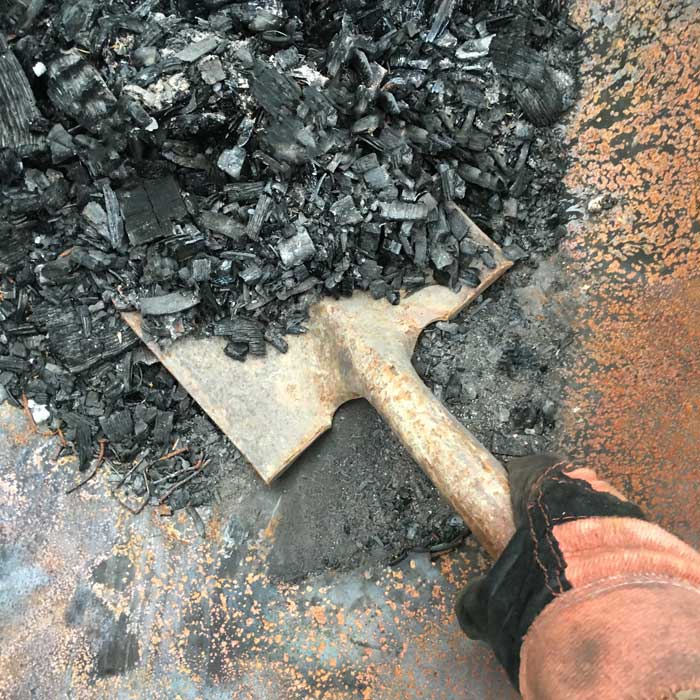
It is best to wear gloves when you clean your firebowl.
7. Will ashes fall through the drain hole if I burn wood?
Yes, a few ashes or coals can fall through the drain hole. You should periodically tip your firebowl on edge to clear these ashes so they do not impede drainage.
On many surfaces such as earth, stone, gravel or brick these ashes present no problem. If you plan to burn wood in your firebowl on a wooden or plastic lumber deck, you MUST place a heat shielding pad, firebrick, concrete paver or a slab of stone under the base. The firebowl does not transfer enough heat to set fire to a deck, but the base gets hot enough to brand marks into the wood.
9. Will you paint my firebowl for me?
No. It’s harder to fix a scratch in paint than it is to paint from scratch, and scratches are likely to occur during shipping. I recommend painting the bowl only once it is on the site where it will be used.
8. What kind of paints can I use to paint my firebowl?
All my firebowls are shipped with a natural patina. You can use a high temperature spray paint to paint your bowl on site. High temp spray paint for grills is available at most any hardware store and will work fine on your firebowl. You can also use high temp automotive spray paints designed for engine blocks. These come in a wider color selection and can be found at auto parts stores.



